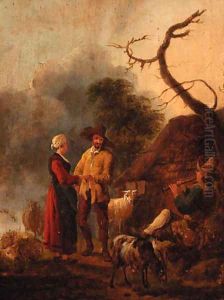Jan Baptist Wolfert Paintings
Jan Baptist Wolfert was a 17th-century Dutch painter, born in 1655 and known for his contributions to the Dutch Golden Age of painting, a period characterized by a remarkable output of high-quality art. Despite the fact that detailed biographical information about Wolfert is scarce, he is recognized for his skillful execution in the genres typical of his time, including landscapes, portraits, and historical scenes.
Wolfert's artistic journey likely began in the Netherlands, a region renowned for its flourishing art scene. During this period, artists were heavily influenced by the socio-political context of the Dutch Republic, which had gained independence from Spain and was experiencing economic prosperity. This environment fostered a burgeoning art market, characterized by a demand for a wide range of subject matter, from domestic interiors and still lifes to grand historical and mythological paintings.
Though Wolfert's body of work might not be as widely recognized as that of his contemporaries, such as Rembrandt or Vermeer, his contributions reflect the vibrancy and diversity of Dutch art during this era. His paintings would have catered to the tastes of the burgeoning middle class, who were keen patrons of the arts, seeking to decorate their homes with works that reflected their interests, values, and social status.
Jan Baptist Wolfert died in 1719, leaving behind a legacy that, while perhaps not extensively documented, contributes to our understanding of the Dutch Golden Age. His work encapsulates the era's artistic spirit, characterized by meticulous attention to detail, a deep appreciation for the interplay of light and shadow, and a keen observation of daily life. Through his art, Wolfert offers a window into the world of 17th-century Netherlands, embodying the era's aesthetic sensibilities and its rich cultural heritage.
